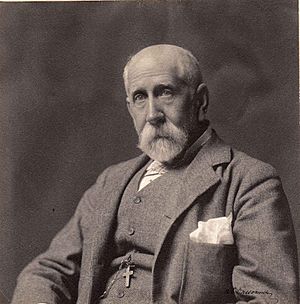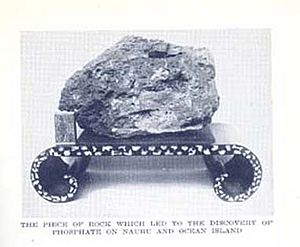John T. Arundel facts for kids
Quick facts for kids
John T. Arundel
|
|
|---|---|
 |
|
| Born |
John Thomas Arundel
1 September 1841 London, England
|
| Died | 30 November 1919 (aged 78) Bournemouth, England
|
| Other names | Aneru |
| Occupation | Entrepreneur |
| Known for | guano and copra |
| Spouse(s) | Eliza Eleanor Whibley "Lillie" |
| Children | Lillian Arundel, Sydney Dorothy Aris |
| Parent(s) | John Arundel, merchant and shopkeeper |
| Relatives | Paternal grandfather, Rev. John Arundel, Home Secretary of the London Missionary Society 1820–1846 |
John T. Arundel (born September 1, 1841 – died November 30, 1919) was an English businessman. He played a very important role in starting the mining of phosphate rock on the Pacific islands of Nauru and Banaba (also known as Ocean Island). Phosphate rock is a natural resource used to make fertilizer, which helps plants grow. People who knew him described John T. Arundel as a "remarkable" and adventurous Christian businessman.
Contents
Early Life and Family Background
John T. Arundel was born in London, England. His father owned a clothing store and a warehouse business near the River Thames. The family lived in Gravesend. They were active members of the Congregational Church. Through a church connection, John joined a shipping company called Houlder Brothers & Co.. This company helped people travel by ship to New Zealand and Australia.
Starting a Career in the Pacific
In 1860, John T. Arundel sailed with Houlder Brothers & Co. into the Pacific Ocean. He visited the Chincha Islands, where guano was mined. Guano is the droppings of seabirds, which is also used to make fertilizer. John became very interested in the fertilizer business. In 1868, his company sent him on another trip to the Pacific to find new business chances.
John T. Arundel wanted to make sure he was financially secure before getting married. So, when he left in 1871 to start his business in the Pacific, his fiancée, Eliza Eleanor (Lillie) Whibley, stayed in England. They finally married in 1881. After their marriage, Lillie Arundel often traveled with John to the islands where his company operated. In 1884, their second daughter was born on Manra, an island then called Sydney Island. They named her Sydney after the island.
John T. Arundel & Co.
In 1871, with money from Houlder Brothers and Co., John T. Arundel started his own company, John T. Arundel & Co. At first, both companies worked together. Houlder Brothers and Co. rented Flint Island from the British government, and Arundel managed the guano mining there from 1875 to 1880. In 1872, they also rented Caroline Island. Arundel's company took over the lease for Caroline Island in 1881.
John T. Arundel & Co. grew to mine guano on many other Pacific islands. They also started coconut farms and traded in copra (dried coconut meat) and other goods. The company was based in Sydney, Australia. Their business in the Pacific included:
- Mining guano on:
- Caroline Island from 1872, and then fully by John T. Arundel & Co. from 1881. They mined about 10,000 tons of phosphate there until it ran out around 1895.
- Baker Island from 1886 to 1899.
- Howland Island from 1886 to 1899.
- Jarvis Island from 1886 to 1899.
- Manra (Sydney Island) in 1884.
- Several islands off the coast of Northern Australia, like Raine Island and Lady Elliot Island.
- Starting coconut plantations on:
- Flint Island in 1881. The farm operated until 1891.
- Caroline Island in 1885, but the coconut trees got sick, and the farm failed.
- Nikumaroro (Gardner Island) in 1892. This farm was abandoned within a year because of a severe drought.
Albert Ellis, who worked for John T. Arundel & Co., later said that the company wasn't making much money. However, they gained a lot of experience in mining and shipping guano and phosphate rock. This was often difficult because many of these islands didn't have safe places for ships to anchor.
The Pacific Islands Company
In 1897, John T. Arundel & Co. joined with another trading and farming company called Henderson and Macfarlane. Together, they formed the Pacific Islands Company Ltd (PIC). This new company was based in London, England, but its main business was in the Pacific. John T. Arundel became the vice-chairman.
The PIC continued to expand its farming interests. In 1899, they got permission to start coconut farms on Birnie Island. They also tried to get licenses for coconut farms in the British Solomon Islands in 1900 and 1901. However, the company often didn't have enough money. The PIC stopped its plans for new coconut farms in 1902.
The Pacific Phosphate Company
In 1899, Albert Ellis made an important discovery. He noticed a rock holding open the Sydney office door looked like the hard phosphate rock he had seen on Baker Island. He sent it for testing, and it turned out to be high-grade phosphate! Albert Ellis and other company workers then traveled to Banaba and found that the island was mostly made of phosphate rock. Ellis then went to Nauru, which was a German territory at the time, and confirmed it also had huge amounts of phosphate rock.
John T. Arundel and Lord Stanmore (the chairman) were in charge of getting money for these new opportunities. They also had to negotiate with a German company that had the rights to mine in Nauru. In 1902, the PIC joined with a German company called Jaluit Gesellschaft of Hamburg. They formed the Pacific Phosphate Company (PPC) to mine phosphate on Nauru and Banaba (Ocean Island).
The company's engineers had to figure out how to get the phosphate rock from the islands onto ships. Both Nauru and Banaba are high islands, meaning they don't have calm lagoons or safe harbors for ships. Despite losing five ships near Ocean Island, the PPC became very successful and made a lot of money.
Because the company was so profitable, people started looking at the original agreements made with the landowners of Nauru and Banaba. For example, the agreement with the Banabans gave the company the right to mine for 999 years for only £50 a year. These agreements were later changed to include payments called royalties and money for any damage caused by mining.
The PPC also looked into phosphate deposits on Makatea in French Polynesia. They formed a company with a Tahitian group. This gave the PPC almost complete control over the best sources of phosphate in the Pacific.
In 1919, the governments of the United Kingdom, New Zealand, and Australia took over the PPC's business in Nauru and Banaba. From then on, these governments were responsible for the well-being of the people of Nauru and Banaba, restoring land and water damaged by mining, and paying for environmental harm.
Key Dates in John T. Arundel's Life
- 1841: Born in England.
- 1872: Started John T. Arundel & Co. in Sydney.
- 1881: Started a coconut plantation on Flint Island.
- 1884: His second daughter, Sydney, was born on Sydney Island.
- 1886: Started guano mining again on Baker Island, Howland Island, and Jarvis Island.
- 1897: John T. Arundel & Co. joined with Henderson and Macfarlane to form the Pacific Islands Company.
- 1902: The Pacific Islands Company became the Pacific Phosphate Company. They began phosphate mining on Banaba in 1901 and phosphate mining in Nauru in 1906.
- 1909: Traveled on the first voyage of the S.S. Ocean Queen to Nauru and Ocean Island. During this trip, he visited Jarvis Island, where his daughter Sydney took photos of a new lighthouse being built.
- 1919: Died on November 30, 1919, in Bournemouth, England.
|


